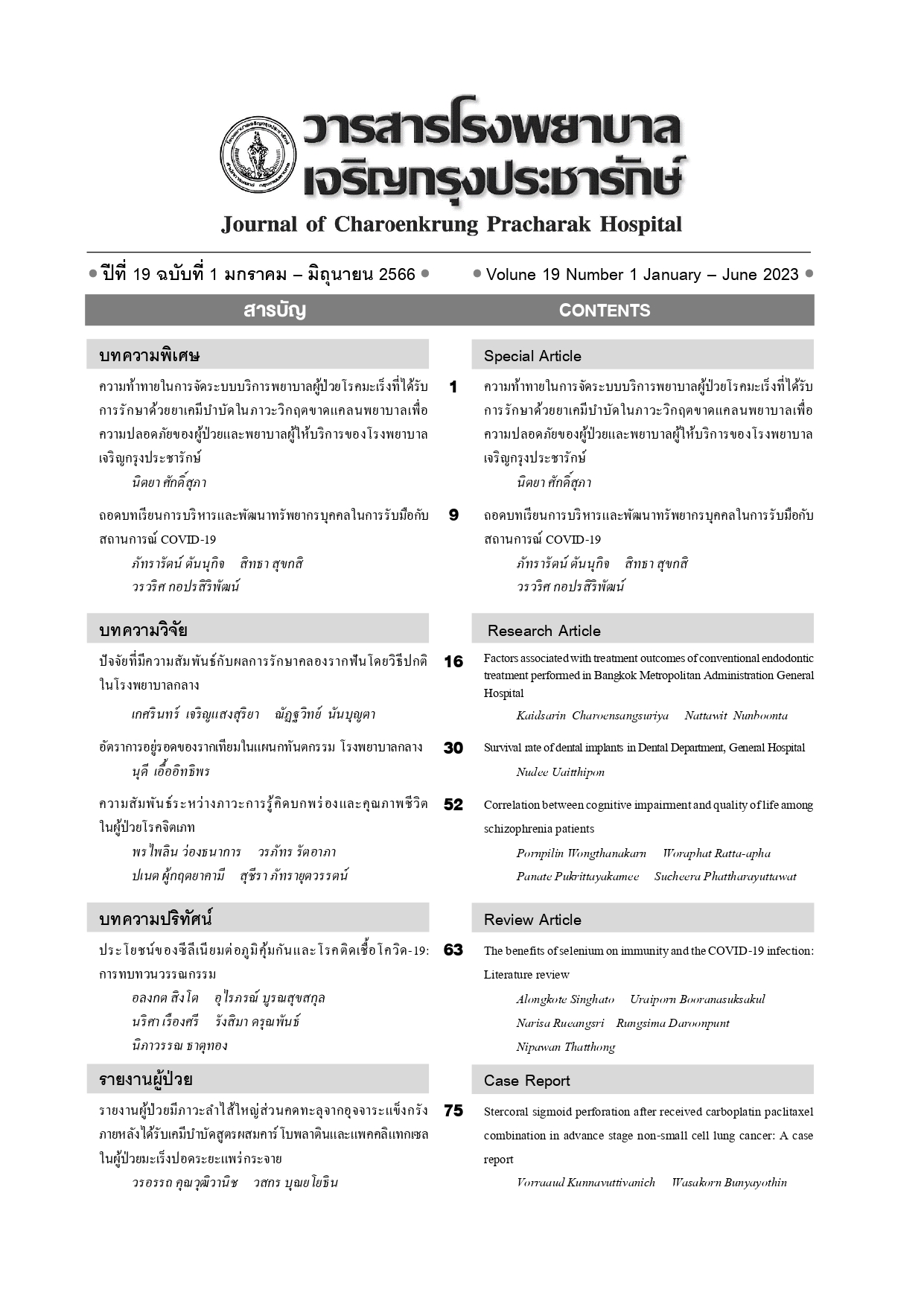ปัจจัยที่มีความสัมพันธ์กับผลการรักษาคลองรากฟันโดยวิธีปกติในโรงพยาบาลกลาง
Main Article Content
บทคัดย่อ
วัตถุประสงค์: เพื่อศึกษาปัจจัยที่มีความสัมพันธ์กับผลการรักษาคลองรากฟันโดยวิธีปกติในโรงพยาบาลกลาง
วิธีดำเนินการวิจัย: การศึกษาแบบย้อนหลังเชิงพรรณนาในผู้ป่วย จำนวน 240 คนที่มารับการรักษาคลองรากฟันโดยวิธีปกติ ตั้งแต่วันที่ 1 มกราคม 2557 ถึง 31 ธันวาคม 2560 และมีการติดตามผลการรักษาถึงวันที่ 31 ธันวาคม 2564 ข้อมูลถูกเก็บบันทึกจากการตรวจทางคลินิกและภาพถ่ายรังสี ประเมินผลการรักษาคลองรากฟันโดยประยุกต์ใช้เกณฑ์ของ Gutmann แบ่งออกเป็น 2 กลุ่ม คือ ผลการรักษาสำเร็จ และผลการรักษาล้มเหลว ทำการวิเคราะห์ข้อมูลโดยใช้สถิติไคสแควร์หรือฟิชเชอร์ กำหนดระดับนัยสำคัญทางสถิติที่ระดับ 0.05
ผลการวิจัย: กลุ่มตัวอย่างส่วนใหญ่เป็นเพศหญิง (ร้อยละ 67.50) มีอายุอยู่ระหว่าง 18-60 ปี (ร้อยละ 62.92) มีสภาวะเนื้อเยื่อในก่อนการรักษาแบบฟันไม่มีชีวิต (ร้อยละ 55.42) สภาวะของเนื้อเยื่อบริเวณปลายรากฟันก่อนการรักษามีรอยโรค (ร้อยละ 72.50) คุณภาพการอุดของคลองรากฟันที่ยอมรับได้ (ร้อยละ 93.75) มีระยะเวลา การติดตามผลการรักษา มากที่สุดในช่วง 61-72 เดือน (ร้อยละ 25.83) สำหรับปัจจัยที่มีความสัมพันธ์กับผลการรักษาคลองรากฟันโดยวิธีปกติ พบว่า สภาวะของเนื้อเยื่อใน สภาวะเนื้อเยื่อบริเวณปลายรากฟันก่อนการรักษา คุณภาพการอุดคลองรากฟัน ระยะเวลาการติดตามผลการรักษา และการบูรณะในส่วนตัวฟันมีความสัมพันธ์กับผลการรักษาคลองรากฟัน อย่างมีนัยสำคัญทางสถิติที่ระดับ 0.05
สรุป: ปัจจัยที่มีความสัมพันธ์กับผลการรักษาคลองรากฟันโดยวิธีปกติในโรงพยาบาลกลาง ได้แก่ สภาวะของเนื้อเยื่อใน สภาวะเนื้อเยื่อบริเวณปลายรากฟันก่อนการรักษา คุณภาพการอุดคลองรากฟัน ระยะเวลาการติดตามผลการรักษา และการบูรณะในส่วนตัวฟัน
Article Details

อนุญาตภายใต้เงื่อนไข Creative Commons Attribution-NonCommercial-NoDerivatives 4.0 International License.
เอกสารอ้างอิง
Kakehashi S, Stanley HR, Fitzgerald RJ. The effects of surgical exposures of dental pulps in germ-free and conventional laboratory rats. Oral Surg Oral Med Oral Pathol 1965; 20: 340-9. doi:10.1016/0030-4220(65)90166-0.
Schilder H. Cleaning and shaping the root canal. Dent Clin North Am 1974; 18: 269-96.
Ng YL, Mann V, Rahbaran S, Lewsey J, Gulabivala K. Outcome of primary root canal treatment: systematic review of the literature - part 1. Effects of study characteristics on probability of success. Int Endod J 2007; 40: 921-39. doi:10.1111/j.1365-2591.2007.01322.x.
Strindberg LZ. The dependence of the results of pulp therapy on certain factors: an analytical study based on radiographic and clinical follow-up examinations. Stockholm: N.G. Mauritzons Boktryckerl 1956; 14: 1-175.
Friedman S, Löst C, Zarrabian M, Trope M. Evaluation of success and failure after endodontic therapy using a glass ionomer cement sealer. J Endod 1995; 21: 384-90. doi:10.1016/S0099-2399(06)80976-3.
Yanpiset K, Jantarat J, Chivatxaranukul P. Endodontic success: a retrospective study based on
clinical and radiographic analysis. M Dent J 2006; 26: 289-98.
Lee AH, Cheung GS, Wong MC. Long-term outcome of primary non-surgical root canal treatment. Clin Oral Investig 2012; 16: 1607-17. doi:10.1007/s00784-011-0664-2.
Grossman LI, Shepard LI, Pearson LA. Roentgenologic and clinical evaluation of endodontically treated teeth. Oral Surg Oral Med Oral Pathol 1964; 17: 368-74. doi:10.1016/0030-4220(64)90510-9.
Bender IB, Seltzer S, Soltanoff W. Endodontic success--a reappraisal of criteria. II. Oral Surg Oral Med Oral Pathol 1966; 22: 790-802. doi:10.1016/0030-4220(66)90369-0.
ลัสกร สงวนดีกุล, จิติมา เอื้อรัตนวงศ์. ผลการรักษาคลองรากฟันโดยประเมินจากลักษณะทางคลินิกและภาพรังสีคณะแพทยศาสตร์วชิรพยาบาล มหาวิทยาลัย นวมินทราธิราช. วชิรเวชสาร 2558; 2: 43-51.
นธร ขจรไพร, ศรัณย์พร วงษ์มานิตย์. ผลการรักษาคลองรากฟันในผู้ป่วยที่ได้รับการรักษาจากคลินิกทันตกรรม โรงพยาบาลพรหมบุรี จังหวัดสิงห์บุรี. วารสารกรมการแพทย์ 2562; 5: 87-94.
เถลิงศักดิ์ สมัครสมาน, อังสนา ใจแน่น, คมสันต์ มนธาตุผลิน, วัชราภรณ์ อินทรา, พัณนิดา มูลศรีแก้ว, กิตติศักดิ์ ทิพรัตน์. อัตราความสำเร็จของการรักษาคลองรากฟันโดยนักศึกษาทันตแพทย์ มหาวิทยาลัย ขอนแก่น. ว.ทันต.ขอนแก่น 2557; 17: 93-102.
Gutmann JL, Dumsha TC, Lovdahl PE. Problem solving in the assessment of treatment outcomes, quality assurance, and their integration into endodontic treatment planning. In: Gutman JL, Dumsha TC, Lovdahl PE, editors. Problem solving in endodontics: prevention, identification, and management. 4th ed. St. Louis: Mosby Elsevier; 2006. p. 1-36.
Friedman S. Treatment outcome and prognosis of endodontic therapy. In: Orstavik D, Pitt Ford TR, editors. Essential endodontology: prevention and treatment of apical periodontitis. Oxford: Blackwell Science; 1988. p. 285-301.
Setzer FC, Kim S. Comparison of long-term survival of implants and endodontically treated teeth. J Dent Res 2014; 93: 19-26. doi:10.1177/0022034513504782.
Salehrabi R, Rotstein I. Endodontic treatment outcomes in a large patient population in the USA: an epidemiological study. J Endod 2004; 30: 846-50. doi:10.1097/01.don.0000145031.04236.ca.
Benenati FW, Khajotia SS. A radiographic recall evaluation of 894 endodontic cases treated in a dental school setting. J Endod 2002; 28: 391-5. doi:10.1097/00004770-200205000-00011.
Imura N, Pinheiro ET, Gomes BP, Zaia AA, Ferraz CC, Souza-Filho FJ. The outcome of endodontic treatment: a retrospective study of 2000 cases performed by a specialist. J Endod 2007; 33: 1278-82. doi:10.1016/j.joen.2007.07.018.
Friedman S, Abitbol S, Lawrence HP. Treatment outcome in endodontics: the Toronto study. Phase 1: initial treatment. J Endod 2003; 29: 787-93. doi:10.1097/00004770-200312000-00001.
Farzaneh M, Abitbol S, Lawrence HP, Friedman S; Toronto study. Treatment outcome in endodontics-the Toronto study. Phase II: initial treatment. J Endod 2004; 30: 302-09. doi:10.1097/00004770-200405000-00002.
Marquis VL, Dao T, Farzaneh M, Abitbol S, Friedman S. Treatment outcome in endodontics: the Toronto study. Phase III: initial treatment. J Endod 2006; 32: 299-306. doi:10.1016/j.joen.2005.10.050.
Ray HA, Trope M. Periapical status of endodontically treated teeth in relation to the technical quality of the root filling and the coronal restoration. Int Endod J 1995; 28: 12-8. doi:10.1111/j.1365-2591.1995.tb00150.x.
Sjogren U, Hagglund B, Sundqvist G, Wing K. Factors affecting the long-term results of endodontic treatment. J Endod 1990; 16: 498-504. doi:10.1016/S0099-2399(07)80180-4.
Vire DE. Failure of endodontically treated teeth: classification and evaluation. J Endod 1991; 17: 338-42. doi:10.1016/S0099-2399(06)81702-4.
Fuss Z, Lusting J, Tamse A. Prevalence of vertical root fractures in extracted endodontically treated teeth. Int Endod J 1999; 32: 283-6. doi:10.1046/j.1365-2591.1999.00208.x.
Murphy WK, Kaugars GE, Collett WK, Dodds RN. Healing of periapical radiolucencies after nonsurgical endodontic therapy. Oral Surg Oral Med Oral Pathol 1991; 71: 620-4. doi:10.1016/0030-4220(91)90374-1.
Orstavik D. Time-course and risk analyses of the development and healing of chronic apical periodontitis in man. Int Endod J 1996; 29: 150-5. doi:10.1111/j.1365-2591.1996.tb01361.x.
Kojima K, Inamoto K, Nagamatsu K, Hara A, Nakata K, Morita I, et al. Success rate of endodontic treatment of teeth with vital and nonvital pulps. A meta-analysis. Oral Surg Oral Med Oral Pathol Oral Radiol Endod 2004; 97: 95-9. doi:10.1016/j.tripleo.2003.07.006.
de Chevigny C, Dao TT, Basrani BR, Marquis V, Farzaneh M, Abitbol S, et al. Treatment outcome in
endodontics: the Toronto study-phase 4: initial treatment. J Endod 2008; 34:258-63.
doi:10.1016/j.joen.2007.10.017.


